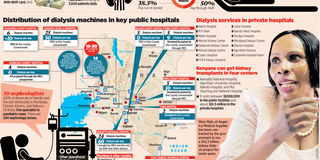Kidney failure no longer a death sentence

Information compiled by Eunice Kilonzo, Sourced from Kenya Renal Association, Council of Governors, respective hospitals. INFOGRAPHIC| MICHAEL MOSOTA
What you need to know:
- With increased awareness about renal diseases, more hospitals offering dialysis, proper diagnoses and follow-up procedures, many patients who only a few years ago would have been left for dead are living their lives to the full.
- Now, with the National Hospital Insurance Fund (NHIF), patients have the option of getting dialysis from several public hospitals and other private facilities.
- Herbal medicine has also been implicated in several studies as the cause of acute kidney injuries that have progressed to long term conditions.
One uneventful afternoon in 1978, a missionary surgeon at the Kapenguria District Hospital accidentally removed the only kidney of a little boy who had undergone surgery in the abdomen.
The child was referred to Kenyatta National Hospital, where an enterprising man named Nelson Awori and a team of 10 doctors conducted a kidney transplant — Kenya’s first.
Now, 39 years later, Mary Njagi, 39, stands in front of Nelson Awori Plaza, named after the man who conducted a procedure that she will have to undergo if she is ever going to live a fulfilled life after her kidneys failed.
Should she get a donor, the transplant will be done at the Kenyatta National Hospital under the watch of Prof Anthony Were, who was Prof Awori’s student more than 31 years ago.
Prof Were is a senior nephrologist at KNH, where he has worked since 1986.
He is also an instructor at the East African Kidney Institute at the University of Nairobi, where doctors, nurses and nutritionists are trained in renal care.
Seated in his office at the Nairobi Hospital, Prof Were reminisces about the history of kidney care and comments dryly about the way he handled patients back then.
Then, the progression of the life of a patient with a chronic kidney disease followed a predictable path: Diagnosis. Discharge. Death.
“It was like a 100 per cent guarantee you would die,” he says.
Now, with the National Hospital Insurance Fund (NHIF), patients have the option of getting dialysis from several public hospitals and other private facilities.
DEVELOPED WORLD DISEASES
The growth of the practice of medicine in post-independent Kenya, even for primary healthcare, has been marred by ingrained attitudes in the government that still plague the health system to date.
Prof Were says KNH has for a long time been the only hospital that offered dialysis. His comments, and other commentaries by historians on medicine in Kenya, point to a growing concern among the medical fraternity about the prevalence of kidney failure and other lifestyle diseases.
In 1988, then minister of health Mwai Kibaki introduced fees to be paid by patients in public hospitals, adding to the healthcare burden for ordinary Kenyans.
Before Moi Teaching and Referral Hospital began offering dialysis in 2000, KNH bore the burden of the disease single-handedly.
The neglect of preventive medicine, among many other miscalculations, slowed down any progress on care for kidneys.
British historian John Iliffe, who is an expert in African history, writes in his book, East African Doctors: A History of the Modern Profession (African Studies), about how the government went into an expansion spree of the public health system after independence, focusing on the curative aspect.
Illife notes that government records showed that between 1962 and 1973, hospital beds increased from 10,617 to 18,186 yet there were hardly any trained professionals to man them.
Then, Kenya’s Ministry of Health was notorious for its huge budgets, which it always over shot by nearly 10 per cent every year.
In 1969, government records on parliamentary debates show that the Ministry of Health’s budget ballooned from £4,566,502 (about Sh576m) to £11,900,534 (about Sh1.5bn) and in 1970 it took up 48 per cent of government expenses.
Despite the availability of money, non-communicable diseases such as cancer, diabetes and blood pressure were rubbished as “diseases of the developed world” and little effort was put into prevention.
The book Evidence, Ethos and Experiment: The Anthropology and History of Medical Research in Africa pays tribute to the efforts of pioneer cancer specialist Edward George Kasili, who fought hard in 1970 to prove that a non-communicable disease (Leukemia) was prevalent in Kenya as anywhere else in the world; Kasili died of cancer in 1997.
Now, the World Health Organisation (WHO) estimates that chronic kidney disease is by three to four times more frequent in Africa than in developed countries.
Scarcity of actual data makes it difficult to quantify the prevalence, but senior kidney specialists who commented on this article quoted between 7,000 to 8,000 new cases every year.
The life of David Mayiani, a patient who has been on dialysis for three years, best exemplifies these historical gaps in healthcare.
In 1994, he complained of a headache and it was not until 2013 when he developed severe chest pains that he was referred to Aga Khan University Hospital in Nairobi. He was hospitalised, and dialysis started right away.
Apart from through acute kidney injuries — those arising from medical conditions that were not related to the renal system — Mayiani would not have found himself in his current situation.
Dr Jonathan Wala, a consultant physician at Aga Khan University Hospital, says some factors predispose people to develop kidney problems. The number one cause is an inflammation of the kidneys, a condition called glomerulonephritis, after a skin or throat infection that was not treated.
Diabetes, uncontrolled blood pressure, Hepatitis A, B and C, as well as Lupus, also increase risk of infection.
Herbal medicine has also been implicated in several studies as the cause of acute kidney injuries that have progressed to long term conditions.
In a series on studies on kidney health, published in The Lancet in 2014, 80 per cent of traditional medicine was thought to be associated with 35 per cent of acute kidney injuries.
RESILIENT ORGAN
Mayiani sought conventional medicine and his current doctor, kidney specialist Ahmed Twahir from Parklands Kidney Centre, told the Nation that with a high suspicion index, a simple urine test would have saved Mayiani’s kidney.
A urinalysis, which costs as little as Sh150 in public hospitals, would have arrested the situation.
The nephrologist blamed lack of knowledge about long-term kidney problems for the rising prevalence of disorders.
Dr Twahir said the basic needs of a patient on dialysis take more than Sh25,000 a week from their pockets and, by extension, the taxpayer.
“The kidney is resilient and gets diseases slowly that the patient would not feel the pain, but by the time your feet is swelling, it is often too late and the doctor has no other option but put you on dialysis as you wait for a transplant,” he said.
Head of the renal unit at KNH, Dr John Ngigi, said that when infection is discovered early, it can be cured before it leads to total failure of the kidney.
There is also the issue of misdiagnosis, and pathologist Ahmed Kalebi said that he has seen cases of patients with irreversible renal failure, but who would have been treated early enough if the healthcare worker that attended to them had interpreted the urinalysis test correctly and followed up on the results properly.
Dr Kalebi said that there is little emphasis on cheap and simple tests as urinalysis since health workers seek to learn more sophisticated methods that are less useful.
“A specific example of cases that are missed then end up as renal failure include those of blood and crystals in urine where medics miss or fail to follow up, because urinalysis is done robotically and in vain,” Dr Kalebi said.
This negligence goes unreported, but it dents the pocket for the patient and the taxpayer.
Last year, at Jaramogi Oginga Teaching and Referral Hospital’s renal unit, a 10-year-old girl was wheeled in after severe malaria attacks affected her kidneys.
Her distraught mother could not raise the money for treatment.
Dr Eddy Mboya, then head of the unit, said the hospital would have to bear the cost of treating the girl as it would any other patient brought there on acute kidney ailment.
He gave an example of the capital cost of the common dialysis in Kenya:
“There should be a renal nurse, a physician or a nephrologist all of whom need to be paid; then the radiology costs, lab, solutions, dialysers as well as medication like blood boosters or for treating any other infection that may arise because of their compromised immunities”
*******
BARE FACTS
There is a Sh700 test that can save you Sh25,000 a week when you develop a kidney disease. This information was distilled from an email from Dr Qazri Nasrin Ahmed, an immunologist at Pathologists Lancet Kenya, on an unrelated topic.
Urinalysis is an informative diagnostic method that can reflect a gross information about kidney function, costing as little as Sh700 in a private laboratory and about Sh200 in public hospital.
The test consists of macroscopy (a visual exam), dipstick (chemistry) and microscopy. The physical exam checks for the colour and appearance of the urine where bloody urine may indicate kidney disease and some other medical conditions.
A urinary tract infection may make the urine greenish and turbid (not clear). Foamy urine might be sign of kidney problem.
The urine dipstick test may reveal protein which indicates that the kidneys’ filtering functions are hampered. From it, there could be traces of glucose, usually a sign of diabetes, while Ketone points to diabetes mellitus.
The dipstick may also show traces of blood, which indicates kidney disease as well as other substances that show one’s kidney is infected.
A dipstick also can also show the acid-alkaline levels (PH) above the normal value points to a urinary tract infection which is risk of developing kidney stone.
Finally, a microscopy test can show traces of red blood cells and crystals, a sign of UTI or kidney disease, or white blood cells, an indication of kidney disease/UTI



